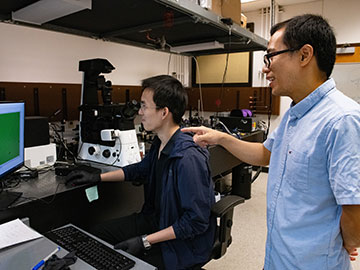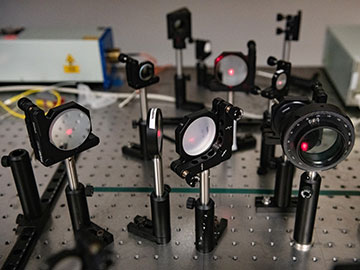
Yuebing Zheng and Siyuan Huang, both of the University of Texas at Austin, USA. [Image: The University of Texas at Austin]
Non-biodegradable plastic waste is a growing global problem. Photonic and optoelectronic devices need carbon dots to store information. Could a single chemical process tackle both of these demands?
A multinational research team has figured out how to zap the molecules in plastics with laser light and thus break them down into more valuable substances such as carbon dots (Nat. Commun., doi: 10.1038/s41467-024-49783-z). The process employs a thin layer of a transition metal dichalcogenide (TMDC) to mediate the breaking and reforming of chemical bonds.
Light-activated chemistry
The plastics that make up many packaging materials and plumbing pipes consist of long chains of monomers, which in turn are filled with carbon–hydrogen bonds. For example, most varieties of polyethylene have the chemical formula (C2H4)n or (H2C=CH2)n.
The covalent C–H bond is thermodynamically strong and relatively unreactive. Under certain conditions, however, scientists can cleave these bonds and make carbon atoms bond with their own kind or with other elements. Most research efforts into this process, called C–H activation, have involved short-chain compounds such as methane instead of the long-chain polymers that make up plastics.
Researchers led by materials scientist Yuebing Zheng, University of Texas at Austin, USA, set up a 2D layer of tungsten diselenide (WSe2), a TMDC semiconductor. On top of that, they placed an organic surfactant known as cetyltrimethylammonium chloride (CTAC), an ingredient in many fabric softeners. Under the beam of a low-power continuous-wave laser with a 532-nm wavelength, the TMDC molecules mediated the breaking of the C–H bonds inside the long-chain surfactant molecules and the subsequent formation of C=C bonds. Spectroscopic analysis confirmed that carbon dots had coalesced out of the carbon.

Multiple mirrors and prisms deflect lasers and focus the light beams to perform the reaction. [Image: The University of Texas at Austin]
First-principles calculations of the kinetic energy barriers for the C–H activation process on WSe2 and other materials used as activation catalysts, such as gold and palladium, revealed that the latter work only for short-chain molecules, not the long-chain variety.
Scaling up?
Jingang Li, University of California, Berkeley, USA, and lead author of the study, is confident that the basic process can be scaled up for real-world applications. “Based on our current understanding and initial experiments, this method is general to many common polymers, organic surfactants, and plastics with C–H bonds,” he says.
One might wonder whether the energy needed to break down plastic waste would negate any environmental savings from reusing plastic. Li admits it is challenging to estimate the energy consumption of future large-scale plastic-zapping projects based on a laboratory-scale experiment, but he and his colleagues will work on scaling up their procedure with larger laser beams or other low-power light sources.
